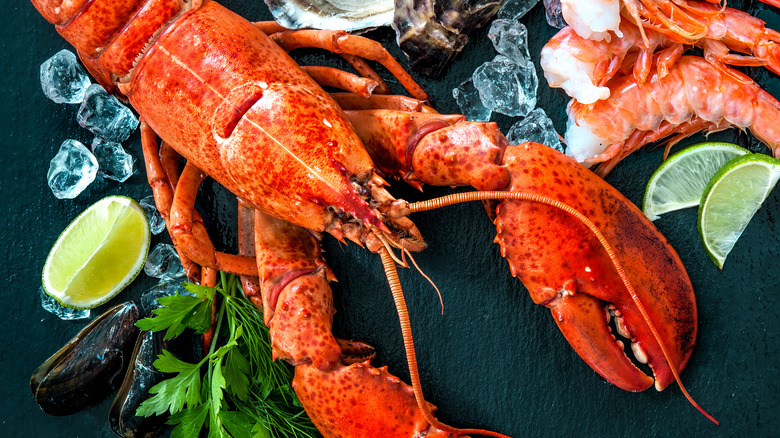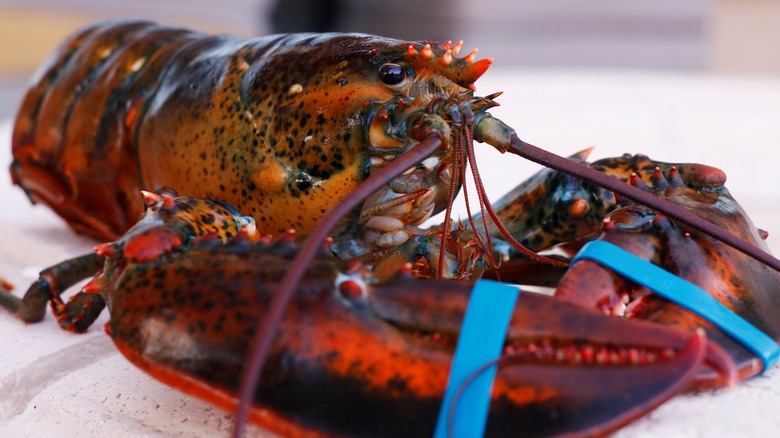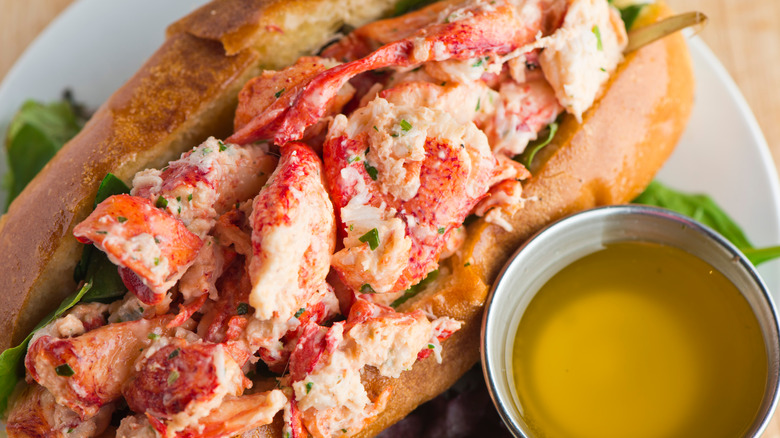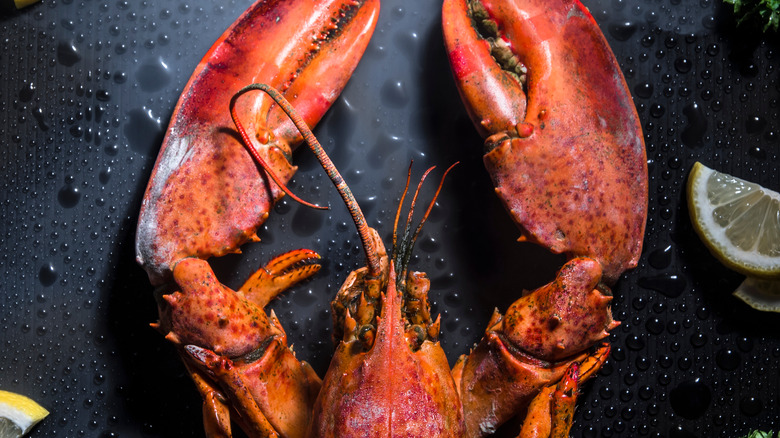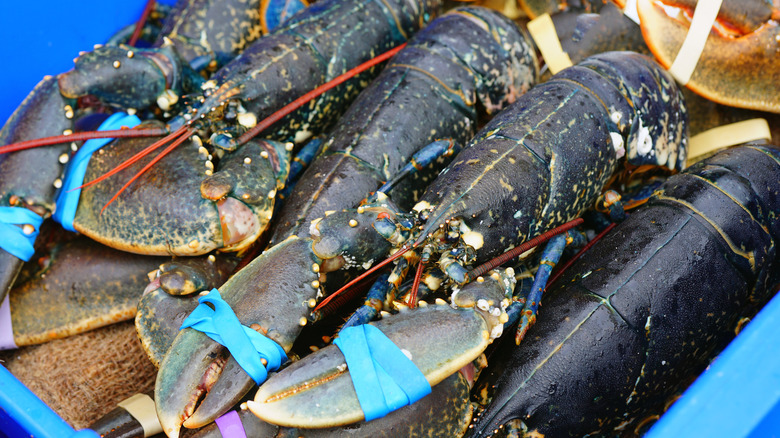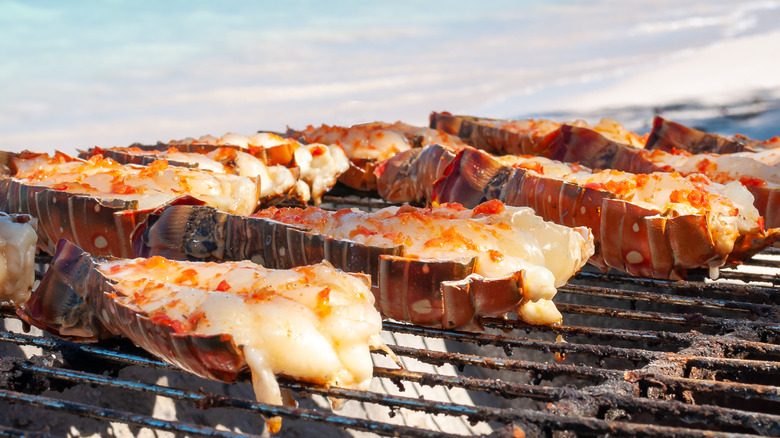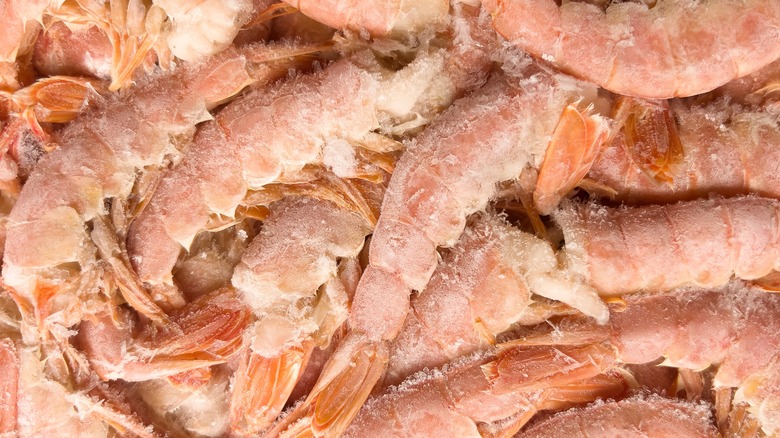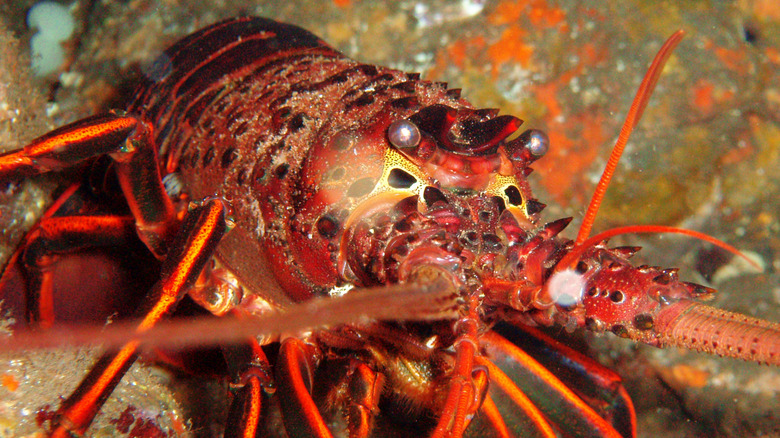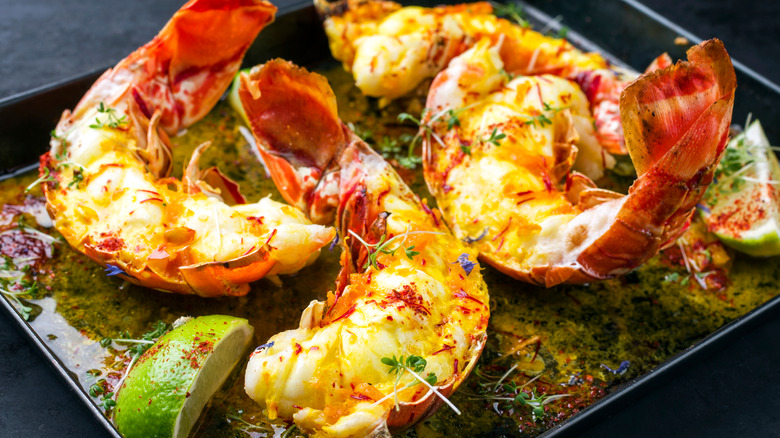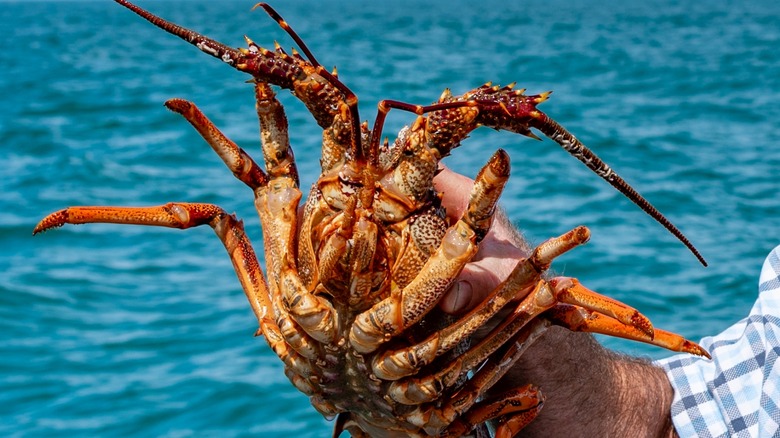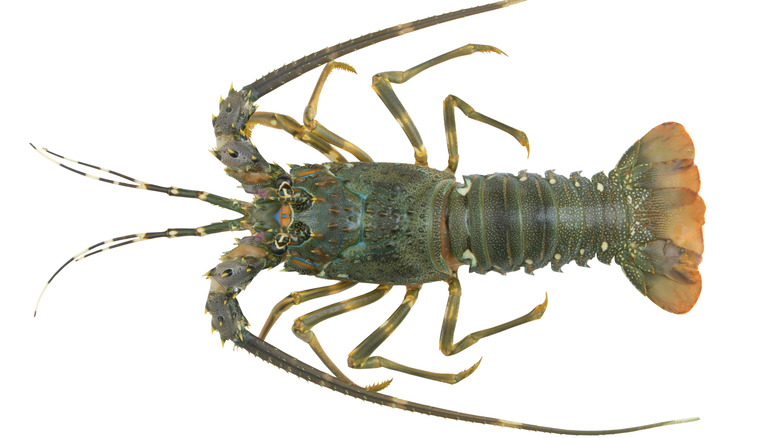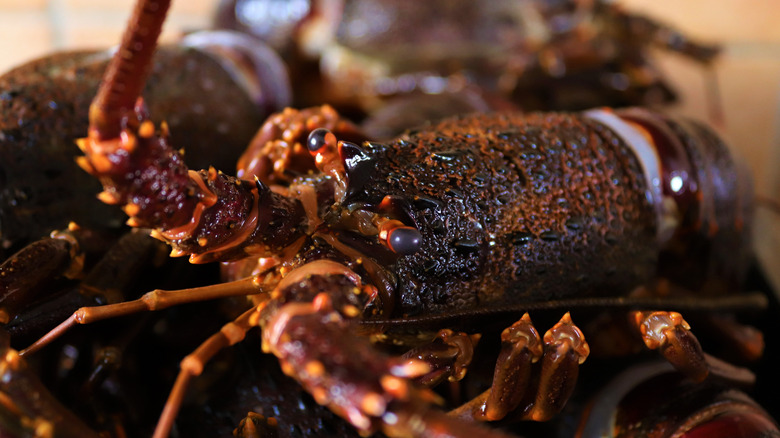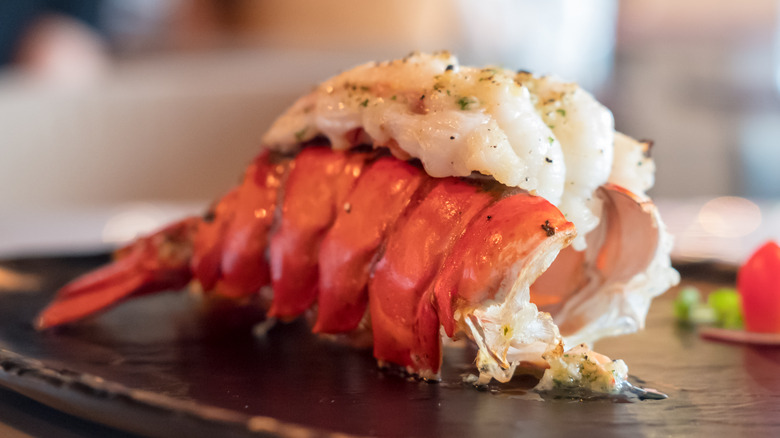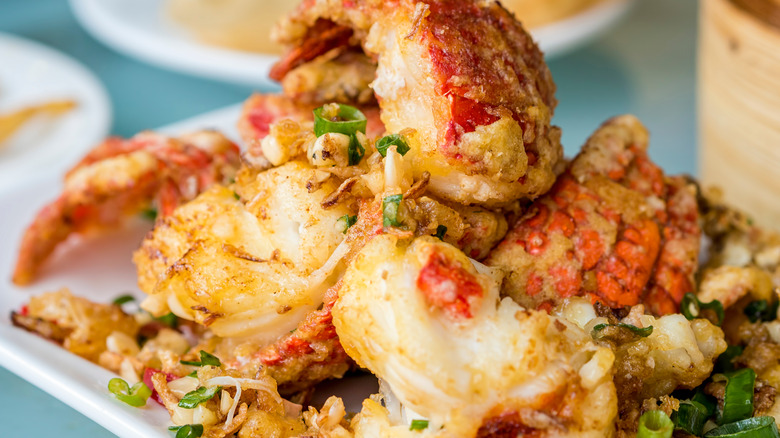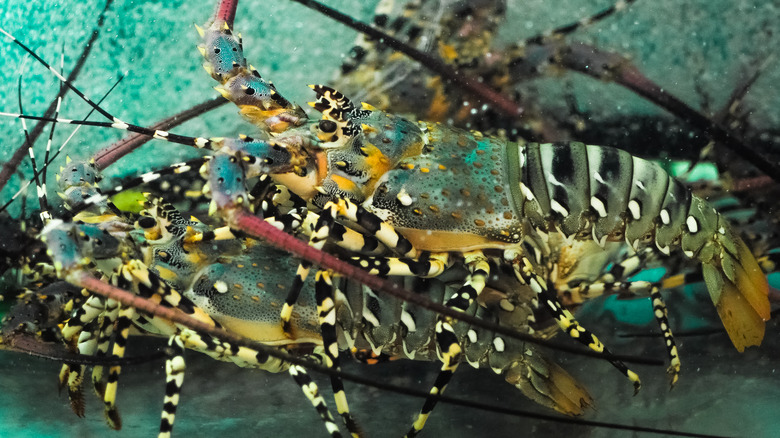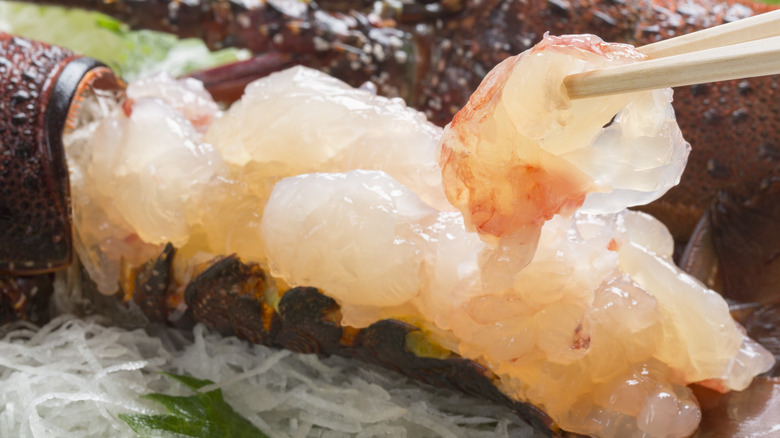16 Types Of Lobster Explained
Lobster is one of the world's most popular luxury dishes. Originally seen as a food for prisoners and the poor, the crustacean's popularity and status surged when preservation and transportation methods advanced to a point where it could be moved from places like the New England coast to the restaurants of affluent Manhattan. Now, you can enjoy lobster almost anywhere in the world — but you will pay a premium for it.
According to the Marine Education Society of Australasia, there are 75 species of lobster inhabiting the world's oceans. Thirty of these species have large claws and tend to inhabit colder waters. The remaining 40, which are commonly called "spiny" or "rock" lobsters, lack large claws on their forlimbs. Not all varieties of lobster are eaten, but of those that are, there are considerable physical differences ranging from color to size to texture. There are also subtle differences in flavor, even among closely related varieties. Here are 16 types of lobster from around the world, along with what makes each of them unique.
Hard shell Maine lobster
If you order lobster at a restaurant or pluck one out of a supermarket's tank in most of the United States, chances are you're getting a hard shell Maine lobster. The Maine lobster itself is technically the same species as the soft shell Maine lobster and the Canadian lobster, but various conditions make it unique (via The Ocean Mart). The Maine Lobster is found in the North Atlantic, off the east coast of the United States, with the highest concentrations being close to New England and Maine specifically, hence the name.
The Maine lobster itself is smaller than the similar Canadian lobster, due to the slightly warmer waters it inhabits. Although it's smaller, the meat tends to be sweeter, which balances things out somewhat. The "hard shell" part of the name refers to the length of time since the lobster last molted. Hard shell lobsters are usually fished between fall and spring. They tend to have around 20% more meat in their shells than soft shell lobsters, and are also more durable. That means hard shell lobsters can be transported further and kept alive longer than soft shell lobsters. So if you live away from the coast and see fresh lobsters in a local restaurant, you can bet they're the hard shell version. Unlike the more delicate soft shell lobsters, hard shells are durable enough to be grilled — so you should consider buying a few if you're a fan of seafood BBQs (via Lobster Anywhere).
Soft shell Maine lobster
The soft shell variant of the Maine (or American) lobster is the exact same species as the hard shell, except it has molted more recently and its exoskeleton is still in the hardening process (via The Ocean Mart). Soft shell lobsters are usually caught in the summer months, and are not as durable as hard-shell lobsters. As a result, transporting them away from the coastal areas they are caught in is extremely difficult. This means that they are extremely abundant in places like coastal Maine, and they tend to be cheaper as a result.
Because their new shell contains a lot of growing room, you'll find less meat inside a soft shell lobster than you would a hard shell of the same weight. However, because the space that would be meat is taken up by water, you can expect extra tender lobste,r as the water within the lobster marinates the meat while cooking (via Wholesale Maine Lobster). For the best results, consider boiling your soft shell lobster in salt water, as this process will not damage the delicate meat. Lobster Anywhere provides instructions on the amount of salt to add and the time you need to boil your lobster. If you want to liven the dish up a bit, consider creating a traditional New England lobster roll by coating chunks of lobster meat in mayonnaise and adding them to a butter toasted hot dog bun.
Canadian lobster
Like the Maine lobster, the Canadian lobster is also of the genus Homarus americanus, meaning they're the exact same species (via The Ocean Mart). However, the colder waters off the Canadian coast produce lobsters that are different enough to gain their own distinction.
Canadian lobsters tend to be larger and not as sweet as their kin south of the border. The shells and meat of Canadian lobsters also tend to be denser. However, the differences aren't that significant, and as "Canadian lobster" isn't as well publicized as "Maine lobster," it tends to be cheaper per pound — so lobster fans could scoop themselves a bargain.
Due to the density of their meat and the thickness of their shells, Canadian lobsters lend themselves well to harsher cooking methods. If you want to try baking or barbecuing a lobster and are looking for a more forgiving variety that comes with fewer financial consequences if you do mess up, a Canadian lobster could be ideal.
European lobster
Homarus gammarus, which is also known as the European lobster, French blue, or common lobster, is a distinct species of lobster found in the seas around Europe. This includes the Atlantic Ocean, North Sea, Irish Sea, Mediterranian Sea, and Baltic Sea. Unlike its American cousin, blue is a common colorof the European lobster, though they turn brick red when cooked.
The European lobster also tends to be smaller than Homarus americanus, but the quantity is offset by quality, as the meat tends to be more flavorful. As lobsters don't tend to travel well, it is nearly impossible to get live European lobster in North America, and frozen French Blues come at a premium. The European lobster spends its time on the sea floor subsisting on small fishes, crustaceans, and shellfish, which all contribute to its fantastic flavor. It is best boiled, but can be baked, barbecued, steamed, or boiled and eaten hot or cold (via Mmmediterranean).
Florida spiny lobster
Like other warm water lobsters (and contrary to their cold water equivalents), the Florida spiny lobster lacks claws (via the Gates Hotel). However, it makes up for this by providing plenty of delicious tail meat. The meat's flavor isn't as sweet or delicate as the kind you'll find under a Maine lobster's shell, but it still tastes great and pairs well with a variety of dishes, from pasta to soup to omlettes to gumbo. The flavor has been described as similar to crawfish.
Also known as the Caribbean lobster, the Florida spiny lobster is a common sight on menus from Key West to Kingston. This lobster's habitat ranges from South Carolina to Brazil. Fresh lobster of this variety tends to be available in Florida for around eight months per year.
This Fish says that before cooking, the Caribbean or Florida lobster's color varies from olive green to brown. They can also be found with yellow spots on their abdomen.
Langoustine
Also known as the Norwegian lobster or Dublin Bay prawn, this small species is popular in cuisines across Europe (via Great British Chefs). One of the more well-known dishes the langoustine crops up in is traditional scampi, though this tends to cost significantly more than the versions that use fish or shrimp. Langoustine season runs from September to May, and the most common fisheries are in the North Sea, close to Norway, Scotland, and off the north east coast of England.
Langoustines tend to be firmer and sweeter than larger lobster species, and they don't have to stand alone in a dish. The late, great Keith Floyd used langoustines alongside monkfish and bass, in what he described as "the best fish stew in the world." Most langoustines available in North America will be frozen, but if you have an opportunity to buy fresh langoustines you should be on the lookout for dark black eyes, lively movements, and no signs of damage to the antennae, legs, or shell.
California spiny lobster
Like the Caribbean lobster, the California lobster is a warm water species and lacks claws (via Vice). However, unlike its East Coast cousin, the California lobster rarely finds itself on a Western plate. Described as "slightly chewy" and as having a "creamy and extremely nutty flavor," the California spiny lobster might just be the West Coast scuba diving community's best-kept secret, as they're the only Americans that have access to them. However, they are quite popular in China, which is where the majority of commercially caught spiny lobsters from California and Mexico end up.
Scripps Institution of Oceanography graduate Kate Masury claims the Chinese prefer clawless lobster species to their cold water counterparts. This demand has driven up the price of the lobsters, leading Americans to select cheaper options. Still, if you manage to get your hands on a California spiny lobster, you may want to treat yourself by boiling them, dousing them with butter, slapping them on a hot grill for a few minutes, and then finishing with even more butter (via OC Wild Seafood).
Mediterranean lobster
Not all European lobsters have claws. Yet another clawless variety of warm water lobster is the Mediterranean lobster (Palinurus elephas), which isn't that common globally, but something you may spot if you frequent seaside markets in Southern Europe.
Contrary to its name, the Mediterranean lobster can be found as far away as the coasts of Great Britain and Ireland. The crustacean has become a bit harder to source after being identified as "vulnerable" by the IUCN in 2013. Recovery efforts have included fishing restrictions and restocking attempts. One of the more promising actions has involved restocking areas where fishing is prohibited with below-legal size lobsters. Within the first few years, this tactic resulted in the "catch per unit effort (CPUE)" of the prohibited areas showing an estimated 300% to 700% increase in "both density and biomass burst" (via Nature.com). The increase in biomass also spilled over into areas where fishing was allowed, with regular fisheries showing a "30–50% increase in density and biomass CPUE."
A traditional rock lobster recipe from the area involves boiling and halving the lobsters before covering them in an oil, lemon juice, and salt, dressing (via SBS).
New Zealand rock lobster
Also known by their scientific name (Jasus edwardsii) and their Maori name (Kōura), the New Zealand rock lobster can weigh between one and ten pounds. Most of that weight is in the tail as, like other warm water lobster species, they have no claws. New Zealand's official seafood website claims the species itself is common in the waters surrounding New Zealand and also crops up all around Australia too. If you're looking for your own New Zealand rock lobster, you can take a clue from their name, as you're more likely to spot one by a rocky area of the coast. They crop up on the east coasts of both the North and South Islands, and around the southwest coast of the South Island.
Like most species of lobster, New Zealand rock lobsters are best boiled in salt water. However, they can also be parboiled and grilled with butter.
Eastern rock lobster
If red or blue aren't your colors, maybe you should try the Eastern rock lobster or Sagmariasus verauxxi, which tends to arrive in a shade of green. The Eastern rock lobster is said to taste "sweet, with a big umami character," and has been described by some of the world's top chefs as the best lobster available (via Delicious).
For those unfamiliar with the term "rock lobster," that means that these are a warm water species that lacks claws. Its front legs are small, and are basically designed to move the creature's eggs around when necessary. This differs from true lobster species like the Maine and European lobsters, whose front legs have adapted into two large claws — one "cutter" and one "crusher" — that are both used in the way their names suggest.
When boiling an Eastern rock lobster, you should weigh it, then aim for one minute per hundred grams plus an additional two minutes.
South African lobster
The South African lobster is a pretty unique species. It is spiny and lacks claws, which you may believe makes it essentially the same as any other rock or warm lobster, but you'd be wrong. It's the South African lobster's similarities to a warm water species that set it apart — because it's actually a cold water lobster.
If you live in the U.S., you are most likely to encounter this lobster variety as a frozen tail (via Wild Oceans). As there aren't any meaty claws on the South African lobster anyway, anyone who isn't a major tomalley fan won't be missing out here. Like many lobster stocks, government regulations are in place to prevent overfishing, so only a limited amount of the South African lobster can be caught each year. The wild lobsters are trap caught, and then frozen at sea to ensure freshness. If you do get ahold of a South African lobster tail, you should consider using the frozen meat to make a few lobster rolls.
Tristan lobster
Caught in deep waters close to the world's most remote island,Tristan da Cunha, the Tristan or St. Paul rock lobster (Jasus tristani) is one of the most expensive and sought-after species of lobster in the world (via Kolikof). This variety of lobster has been described as having a "sweet, succulent flavor and a plump texture beyond compare." The lobster's unique flavor may come from its diet, which is predominantly vegetarian.
Tristan lobsters tend to be on the smaller side, with the average tail weighing between three to five ounces, though some examples can weigh as much as ten. There is also an ethical element that comes with Tristan lobsters. The inhabitants of the island know how important the lobsters are to their economy. As a result, the waters around Tristan da Cunha are "considered to be one of the best managed and sustainable lobster fisheries in the world. Due to their smaller size, you may want to make Tristan lobster tails the center piece of a seafood combination plate" (via Seafood Connection).
Chinese spiny lobster
The Chinese spiny lobster, also known as the Hong Kong rock lobster or Panulirus stimpsoni, is a small species of warm water lobster that tends to be net caught and sold in local markets. The City University of Hong Kong describes the species as "generally green," with small white spots and numerous spines. Common fishing locations for the Chinese spiny lobster include the seas around Guangxi, Guangdong, Taiwan Island, and Fujian. Total body lengths for the Chinese rock lobster range between six inches and one foot, but specimens as large as 20 inches have been reported.
As the Global Times reports, lobsters are important in Chinese culture. The country imports hundreds of millions of dollars worth each year from countries like the U.S. and Vietnam. If you're looking for a Chinese lobster recipe, consider stir-frying pieces of lobster with scallions before adding a Cantonese sauce (via Wok and Kin).
Ornate rock lobster
Panulirus ornatus or the ornate rock lobster is native to the waters of Southeast Asia and Northern Australia, though specimens have been recorded as far away as the Mediterranian sea. As you may have guessed, the ornate spiny lobster's name comes from their appearance, as they look quite striking (literally). This lobster's shell is mainly cream and blue, but may feature orange, pink, and purple, too. This species is large, capable of growing up to 20 inches or more in a relatively short time frame. It is this size and their "outstanding taste" that has led to the ornate spiny lobster being widely fished and eaten (via Sea Unseen).
The ornate rock lobster is also heavily farmed in Vietnam, which is the only country that successfully farms lobsters on a large scale. The lobster farming practice, which involves capturing young lobsters and then fattening them up, started midway through the '90s and grew from there (via Namnam.net). Most of the lobsters Vietnam farms make their way to China, where they sell for a premium.
Western rock lobster
One of Australia's four main lobster species, Panulirus cygnus or the Western rock lobster is predominantly caught off the coast of Western Australia. Colloquially known as crayfish, the lobsters can weigh as much as 11 pounds, and live for around 20 years. According to SeaPedia, the species accounts for around one-fifth of the total value of Australia's seafood from fisheries, making it one of the country's most important single-species lobster varieties. In terms of taste, the lobster's meat is described as having a creamy, sweet flavor.
The Western Rock Lobster Council has a recipe for a "Western Rock Lobster Pappardelle," which involves taking four of the lobsters' tails, cutting them in half, taking out the digestive tract, removing the meat from the shell, and cutting the meat into small pieces and frying with olive oil, garlic, and parsley before mixing them with pasta. Be careful not to overcook the delicate meat, though, especially as the protective shell is no longer present. Still, it is an interesting alternative to simply boiling the meat in salt water.
Scalloped spiny lobster
According to the Journal of Crustacean Biology, the scalloped spiny lobster (Panulirus homarus) inhhabits the waters around India, Asia, and the east of Africa. This nocturnal species spends the day hidden in reefs and sub-aquatic caves, and comes out at night to feed.
Although its dressier cousin, the ornate spiny lobster, is the most commonly farmed lobster species, the scalloped spiny lobster has also been identified as an ideal candidate for aquaculture (via The Fish Site). Huge global demand for the delicious sea bugs is being left unfulfilled, and an increase in farmed lobster may be the sustainable solution everyone has been looking for.
Despite being more common in the waters around India, the biggest consumer of the scalloped spiny lobster is China, with most Chinese consumers using the crustacean as a celebration dish. The species is considered safe to eat raw, so you may actually see lobster sashimi on the menu in some Asian restaurants (and it's likely that the slices of raw lobster will have come from P. homarus).
